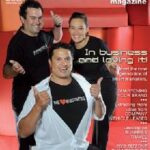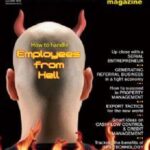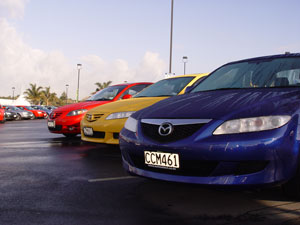SHARPENING YOUR BRAND
A recession is the perfect laboratory in which to polish your brand and make it really stand out. Kevin Kevany has advice from the brand marketing experts.
|
We went to local branding experts to ask them what can be done in these tumultuous times by SME brand custodians to limit the damage, exploit (if that’s possible) the opportunities the new dynamic presents and emerge relatively unscathed. Since it’s branding we’re talking about here, there are going to be winners and losers. That’s what it’s all about, after all. Jill Brinsdon, brand strategist from brand communications company, Radiation, didn’t mince her words. “Don’t be scared of standing out from the crowd. In 2009 you should be far more scared of blending in! The most dangerous thing a brand can be in 2009 is bland. “A mistake we see many businesses make is to position their product or service with values or promises that really should be implicit and that all their key competitors share – for example, a top end food product saying ‘it’s about high quality’. “So it should be! And so are your competitors. So why should I choose you over them again?” To stand out, Brinsdon reckons a brand has to represent something beyond itself; it has to be imbued with a unique and memorable attitude that tickles the fancy of the customer in some way. It must comfort them, entertain or charm or inspire them. “Brands are like people really; we remember the interesting engaging ones, not the wallpaper.” Mark Di Somma from “The key point about any powerful and long-standing brand is that it must continue to evolve,” he says. “It’s very tempting to believe that once you have an established brand, you can simply leave it to do its work and just manage its usage. However, brands evolve within the context of a marketplace, and markets are always changing – both in terms of preference and expectation – because they are made up of consumers who want to continue to be stimulated.” So the motivation to stand out is not dependent on the economy. It’s a necessity of competition. And that’s why it’s so important for SME owner/managers to always be thinking about what the competition is doing and how they are going to stand apart from them. “When you think about brand development in those terms, a recession is just another reason – a reminder in fact – to continually adapt your brand to ensure it remains competitive. Many of the brand failures we are seeing right now, I believe, were already in train before the recession started. What the financial crisis has done is simply speed up the decay process.” Stick to the basics Lynell Tuffery, a senior associate at A J Park, the intellectual property solicitors, warns that in times of a recession the temptation is to cut all budgets. “The marketing budget, including any costs associated with brand protection and investment, is usually the first expense to be cut. But investment in your brand during economic downturn, including developing new branding and marketing strategies, will strengthen your brand, improve customer loyalty, and increase your long-term profit margins. “Despite the drop in brand values, investment in your brand will provide your organisation with long-term financial benefits – if you simply stick to the basics. “But recognise customers are not always rational during straightened times. So you need to find out what is driving your customers in the current environment? What continues to motivate them to buy your products? Researching their needs and finding out how they now identify with your products is important. Tuffery also believes changed circumstances, including the financial, health awareness and a general “greening” trend, require additional proactive responses. “Opportunities may exist for product-line extensions. These opportunities can foster your brand’s development and improve profits. A great example of using extensions to evolve a brand is McDonalds’ ‘healthier choices’ value menu. McDonalds identified a group of customers and targeted that group with a unique marketing campaign. It has now reported a 14 percent growth in profit worldwide at a time when some businesses are struggling to preserve market share.” Audacity Group’s Di Somma agrees it’s vital to keep attuning your brand, and therefore the business model which supports that brand – rather than discounts it – to your consumers’ confidence levels. “In harder times, that may well mean changing your price point to reflect what people believe they can afford (the key word here is “believe”), but you need to make changes to the business to ensure that the arrangement is viable, otherwise you are simply discounting your way to bankruptcy.” He points to the very current “rise and rise of house-brands in supermarkets and retail stores”. “The rise of house brands is a classic example of thinking outside the box and rewriting the rules, so everyone benefits. The key to growth is continuing change, which means successfully reading the economy and making changes that address the shifting priorities of consumers. “Big stores like Walmart and Target have recognised they can deliver what people want in a financial crisis, at a price that is still profitable, if they offer house-brand versions of the goods shoppers formerly bought from other manufacturers. “So, instead of just stocking everyone else’s bread or coffee, for example, stores are now offering their own brands. And they have packaged these brands to look attractive and priced them to feel sensible.” Don’t compete on price Is it coincidental that Walmart has moved to the top of the brand poll normally dominated by retail products rather than stores?
|
Di Somma again: “By developing house-brands which give consumers access to quality products at good prices, these stores are also strengthening their own brands. They have evolved the very nature of the house-brand, from a no-frills item to a viable alternative for cost-conscious shoppers; improved those brands into loyalty-leaders; and given consumers the confidence to “splash out” on the other brands they still have in-store, as a treat. “But resist any temptation to compete on price. Customers who buy when prices are low will not buy when prices return to normal levels. Look after the customers you have and look for ways to encourage these customers to continue buying from you,” says Di Somma. “And keep contact with your customers. During economic downturns, customers do not stop buying. Instead, customers are more selective. As others cut their marketing spend, you can grab a larger share by being constant. Be creative by exploring alternate and cost-effective opportunities to communicate with your customers,” he says. When it comes to extending your brand presence, online is the way to go, according to Mark Allison, Australasian territory manager for WebTrends. “With more Kiwis spending more time online than ever before, there has never been a better time to understand the value of online advertising to reach out to customers and potential customers. “Traditional advertising is expensive, hard to measure and can be targeted at a very broad spectrum of consumers. By comparison, online advertising [branding] gives you a way to connect with niche groups of people in a targeted and measurable way, for a significantly lower investment.” And once engaged, the effects can be immediate. Customers can click through to a website from the advertisement and immediately begin shopping or gathering additional information. “Their actions aren’t delayed by time or distance, because they can act upon their interest straight away – offering a better chance of conversion,” says Allison. Brand protection John Hackett, a senior partner at A J Park, is well-known for his use of case studies to make a point – in this case on brand protection. His message is succinct and appropriate; always be sure you have your brand fully protected – whatever the circumstances. Take the example of the sale of Rolls Royce. “When the giant Volkswagen beat the smaller BMW company (which had previously secured the acquisition of Rolls Royce) in what was effectively a ‘run-off auction’, they were ill-prepared and hadn’t done their homework, while parting with US$795-million. “That lack of attention to detail cost them the trademarks, which were subsequently bought by BMW from Rolls-Royce PLC (aircraft), which had acquired them back in 1973 (in a corporate restructure), for a mere US$65 million dollars. “Today, the ‘Rolls Royce’ factory, which was one of the few assets Volkswagen gained, makes Bentley cars for them, while BMW happily churns out vehicles with the trademarked Rolls-Royce grill and the famed “Spirit of Ecstasy” bonnet icon – all under the Rolls-Royce brand, at less than a tenth of the cost. “Be warned, trademarks and brands are seldom, if ever, just part of the deal. And, never assume that because you have registered the company name, you automatically own all the other rights. “A trade mark registration makes enforcing your rights much easier. It puts a fence around your brand name, or logo, and acts as a deterrent to others thinking of adopting a similar mark. It also provides you with a strong basis to take action if a competitor adopts a brand that is the same as, or similar, to yours for the same, or a similar, product. “Creating a strong brand from the outset means it will become one of your most valuable business assets,” says Hackett. Live your brand The final word belongs to Radiation’s Jill Brinsdon: “It’s important that your brand values and personality come from the truth of who you are and what you’re selling. It has to be sustainable and you have to be able to ‘live it’ every day – not just via your packaging or logo but via your behaviour, your staff, your environment, your website, everything. “Every single interaction with your brand should be consistent, and remind the consumer why they should be loyal to you. If you can’t sustain it every day in every way, no amount of promotional money will make the consumer believe you or buy into you for long. Your brand will fizzle out – guaranteed. “In tough times, it’s even more important to protect, nourish and exemplify your brand and your points of difference, says Brinsdon. “Our research consistently tells us the consumer gravitates towards the familiar, the authentic and the trustworthy in times of uncertainty.” Kevin Kevany is an Auckland-based freelance writer. Email [email protected] This article can also be accessed on the NZBusiness website: www.nzbusiness.co.nz
|





